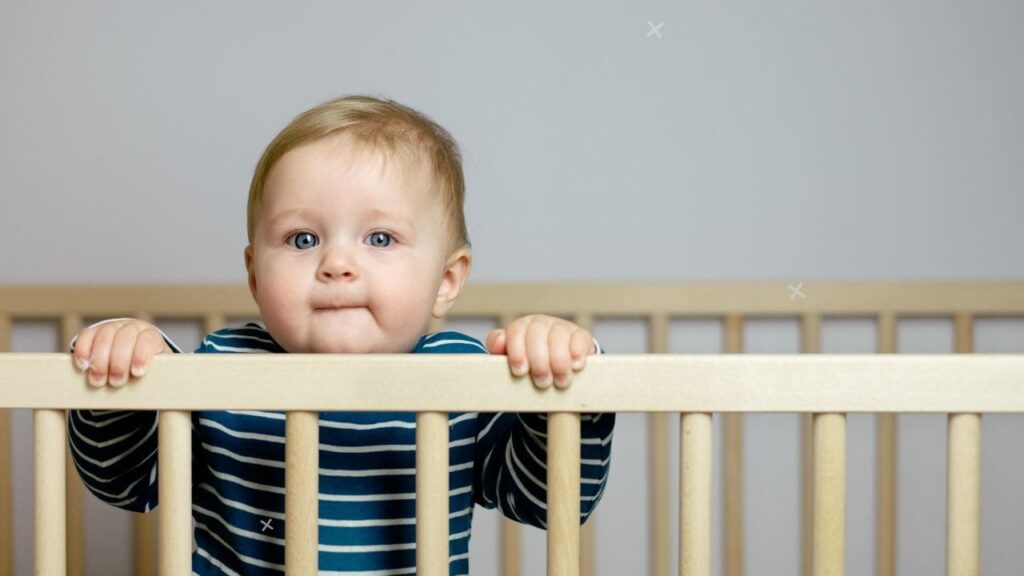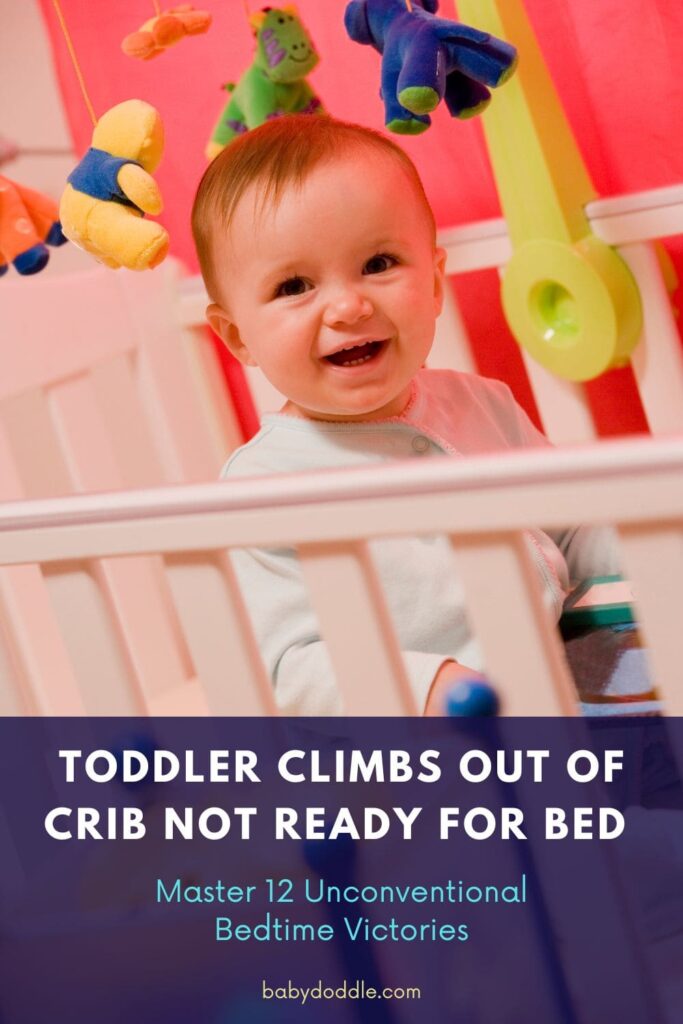Picture this: You’ve just tucked your little one into their crib, kissed them goodnight, and tiptoed out of the room. You breathe a sigh of relief, ready to enjoy some well-deserved adult time. But wait – what’s that sound? Before you know it, your pint-sized Houdini has scaled the crib walls and is toddling down the hallway with a mischievous grin. Sound familiar? You’re not alone in this nighttime struggle!
When your toddler climbs out of crib not ready for bed, it can feel like you’re trapped in an endless game of “whack-a-mole” – except the mole is your adorable, energetic child who’s decided sleep is optional. It’s a phase that can leave even the most patient parents feeling frazzled and desperate for solutions. But don’t worry, we’ve got your back!
In this comprehensive guide, we’ll dive deep into the world of crib escapees and explore 12 unconventional bedtime victories that’ll help keep your little adventurer safely tucked in. We’ll uncover the reasons behind this behavior, tackle safety concerns, and arm you with a toolbox full of creative strategies. So grab a cup of coffee (you’ll need it!), and let’s embark on this wild journey of toddler sleep together.
Understanding Why Toddlers Climb Out of Cribs
Before we jump into our bag of tricks, let’s take a moment to understand why your toddler is suddenly channeling their inner mountain climber. It’s not just to drive you crazy (though it might feel that way sometimes!). There are actually several developmental reasons behind this behavior:
- Physical Development: Around 18 months to 2 years, toddlers experience a significant boost in their gross motor skills. Suddenly, they can climb, jump, and maneuver in ways they couldn’t before. That crib rail? It’s basically Mount Everest, begging to be conquered!
- Cognitive Growth: Your little one’s brain is developing rapidly, leading to increased curiosity and problem-solving skills. The crib represents a puzzle to be solved – and boy, are they determined to crack it!
- Independence: As toddlers grow, they start to crave independence. Climbing out of the crib is often their way of asserting control over their environment.
- FOMO (Fear of Missing Out): Yes, even toddlers can experience this! They might hear household noises or sense that fun things are happening without them, spurring their desire to escape.
- Separation Anxiety: Some toddlers climb out because they’re anxious about being apart from you. It’s their way of seeking comfort and closeness.
Understanding these motivations can help us approach the problem with empathy and creativity. Remember, your toddler isn’t trying to make your life difficult – they’re just navigating their rapidly changing world the best way they know how.
Safety First: Assessing the Risks
Before we dive into our unconventional bedtime victories, let’s talk safety. A toddler climbing out of crib not ready for bed isn’t just a sleep issue – it’s a safety concern that needs immediate attention.
The risks associated with crib climbing include:
- Falls and injuries: The most immediate danger is your toddler falling while attempting to climb out, potentially leading to bruises, sprains, or even fractures.
- Unsupervised wandering: Once out of the crib, your toddler has free reign of their room (and potentially the house), exposing them to various hazards.
- Sleep disruption: Frequent escapes can lead to overtiredness, affecting your child’s mood, behavior, and overall development.
| Age Range | Crib Safety Recommendations |
| 0-5 months | • Use a firmly fitted sheet • No loose bedding or toys • Mattress at highest position |
| 6-8 months | • Lower mattress to middle position • Remove mobiles and hanging toys |
| 9-12 months | • Lower mattress to lowest position • Remove bumper pads if used |
| 12-18 months | • Watch for climbing attempts • Consider sleep sacks to limit mobility |
| 18+ months | • Assess readiness for toddler bed • Implement climbing prevention strategies |

To create a safer sleep environment:
- Lower the crib mattress to its lowest setting.
- Remove any toys or objects that could be used as “stepping stones” out of the crib.
- Ensure the area around the crib is clear of furniture or items your toddler could fall onto.
- Consider using a baby monitor with video capabilities to keep an eye on your little escape artist.
Remember, while it’s tempting to add “crib tents” or other makeshift barriers, many of these are not safety-approved and could pose additional risks. Always prioritize safety-tested, age-appropriate solutions.
Now that we’ve covered the why’s and safety concerns, let’s dive into our 12 unconventional bedtime victories to keep your toddler safely and happily in their crib!
12 Unconventional Bedtime Victories for Crib-Climbing Toddlers
The Backwards Pajama Trick
This simple yet effective strategy involves putting your toddler’s pajamas on backwards. It sounds silly, but it works! Here’s why:
- The zipper or buttons are now at the back, making it harder for little hands to undo.
- It creates a minor inconvenience that can discourage climbing attempts.
- It doesn’t restrict movement for sleep but adds an extra step to the escape plan.
To implement this trick:
- Choose pajamas with zippers or buttons for maximum effectiveness.
- Ensure the backwards fit isn’t uncomfortable or restrictive.
- Explain to your toddler that this is a fun new way to wear pajamas, making it a positive experience.
Remember, this method works best for younger toddlers who haven’t quite mastered complex problem-solving yet. As with any sleep strategy, consistency is key.
The Sleep Sack Solution
Sleep sacks are wearable blankets that can be a game-changer for crib climbers. They provide warmth and comfort while limiting mobility just enough to discourage climbing. Here’s why they’re effective:
- They keep legs partially restricted, making it harder to swing over the crib rail.
- They provide a sense of security, which can improve sleep quality.
- They eliminate the need for loose blankets, enhancing safety.
Choosing the right sleep sack:
- Opt for ones designed for toddlers with adequate room for movement.
- Look for models with foot openings for older toddlers who are walking.
- Choose breathable fabrics to prevent overheating.
Pro tip: Introduce the sleep sack as a “special sleeping superhero cape” to get your toddler excited about wearing it!
The Lowered Mattress Maneuver
Sometimes, the simplest solutions are the most effective. Lowering the crib mattress to its lowest setting can make a big difference:
- It increases the height your toddler needs to climb, making escape more challenging.
- It buys you time as your child grows and develops more climbing skills.
- It’s a free and easy adjustment that doesn’t require any new purchases.
How to implement:
- Check your crib’s manual for instructions on adjusting the mattress height.
- Ensure there are no gaps between the mattress and crib sides after lowering.
- Remove any bumpers or padding that could be used as climbing aids.
Remember, this strategy works best when implemented early, before your toddler has mastered the art of crib escape.
The Crib Tent Tactic
While not suitable for all situations, a crib tent can be a temporary solution for persistent climbers. These mesh coverings fit over the crib, creating a barrier to climbing out. However, it’s crucial to approach this option with caution:
Pros:
- Provides a physical barrier to climbing out
- Can offer peace of mind for parents
Cons:
- Not recommended by many pediatricians due to safety concerns
- May cause anxiety in some children
If you choose to use a crib tent:
- Only use products specifically designed for this purpose and follow all safety guidelines.
- Never leave your child unattended in a crib tent for extended periods.
- Consider it a short-term solution while working on other sleep strategies.
The Bedtime Routine Revamp
Sometimes, the key to keeping your toddler in their crib is all about what happens before bedtime. A solid, consistent routine can work wonders:
- It helps signal to your child that it’s time to wind down and prepare for sleep.
- It can reduce anxiety and restlessness that might lead to escape attempts.
- It provides quality bonding time, filling your child’s “emotional cup” before bed.
Creating an effective bedtime routine:
- Start the routine at the same time each night.
- Include calming activities like reading, gentle songs, or quiet play.
- Avoid screens for at least an hour before bed.
- Keep the routine to about 30 minutes to prevent it from dragging on.
Sample bedtime routine:
- 7:00 PM: Bath time
- 7:15 PM: Pajamas and teeth brushing
- 7:25 PM: Storytime (2-3 short books)
- 7:40 PM: Quiet cuddles and a lullaby
- 7:45 PM: Into the crib with a goodnight kiss
Remember, consistency is key. Stick to your routine even on weekends or during travel to maintain its effectiveness.
The Reward Chart Challenge
Positive reinforcement can be a powerful tool in encouraging desired behaviors, including staying in the crib. Here’s how to implement a reward chart:
- Create a simple chart with spaces for each night of the week.
- Use stickers or drawings to mark successful nights (when your toddler stays in the crib).
- Offer a small reward after a certain number of successful nights.
Tips for success:
- Keep rewards small and immediate (e.g., a special breakfast, extra playtime).
- Celebrate the process, not just the outcome.
- Be consistent with marking the chart and giving rewards.
Remember, the goal is to make staying in the crib a positive experience, not to punish climbing out.
The Gradual Retreat Method
This gentle sleep training technique can help toddlers feel secure without needing to climb out. Here’s how it works:
- Start by sitting next to the crib until your child falls asleep.
- Gradually move your chair further away each night.
- Eventually, you’ll be able to leave the room while your child is still awake.
This method:
- Provides reassurance to anxious climbers
- Teaches self-soothing skills
- Can be adapted to your child’s comfort level
Remember, progress may be slow, but consistency is key. It might take a few weeks, but many parents find this method effective and gentle.

The White Noise Wonder
Never underestimate the power of a good sound machine! White noise can:
- Mask household noises that might stimulate curiosity
- Create a consistent sleep environment
- Signal that it’s time for sleep
Choosing the right white noise:
- Opt for continuous sounds rather than nature noises with pauses
- Keep the volume low, about the level of a soft shower
- Place the machine away from the crib for safety
Pro tip: Use the same white noise sound for naps and nighttime sleep to create a consistent sleep cue.
The Comfort Object Connection
A special stuffed animal or blanket can provide security and reduce the urge to climb out. Here’s why it works:
- It offers comfort when parents aren’t present
- It becomes associated with sleep, acting as a sleep cue
- It gives your toddler something to focus on besides escaping
Choosing a comfort object:
- Let your child pick it (within reason)
- Ensure it’s safe for sleep (no small parts, breathable)
- Consider having a backup in case of loss or laundry day
Remember, introduce the comfort object gradually, making it a part of the bedtime routine.
The Bedroom Makeover Magic
Sometimes, a change in sleep environment can make all the difference. Consider these adjustments:
- Use blackout curtains to darken the room
- Ensure the room temperature is comfortable (around 68-72°F)
- Remove stimulating toys or decorations
- Add a soft nightlight if your toddler fears the dark
The goal is to create a calm, cozy space that your toddler wants to stay in. You might even involve them in some of the decisions, like choosing new sheets or a special “sleep time” poster.
The Consistent Consequence Approach
While positive reinforcement is crucial, it’s also important to have a plan for when climbing occurs. Here’s a gentle approach:
- Calmly and quietly return your toddler to the crib without engaging in conversation.
- Say a simple phrase like “It’s sleep time” and leave the room.
- Repeat as necessary, maintaining a boring and consistent response.
This method:
- Avoids giving attention (even negative attention) for the behavior
- Teaches that climbing out doesn’t lead to any exciting outcomes
- Maintains boundaries consistently
Remember, stay calm and neutral. Your toddler may test your resolve, but consistency is key.
The Early Bedtime Experiment
It might seem counterintuitive, but sometimes an earlier bedtime can lead to better sleep and fewer escape attempts. Here’s why:
- Overtired children often have more difficulty falling and staying asleep
- An earlier bedtime can align better with your child’s natural sleep rhythms
- It can prevent the “second wind” that often comes with overtiredness
How to implement:
- Gradually move bedtime earlier by 15-minute increments
- Watch for signs of optimal bedtime (rubbing eyes, yawning, becoming calmer)
- Adjust your routine to accommodate the new schedule
Remember, the right bedtime can vary by child and may change as they grow. Be prepared to adjust as needed.
When to Consider Transitioning to a Toddler Bed
While our goal is to keep your toddler safely in their crib, there comes a time when transitioning to a toddler bed becomes necessary. Here are signs your child might be ready:
- Consistently climbing out of the crib despite interventions
- Height reaching 35 inches or half the height of the crib side
- Showing interest in a “big kid” bed
- Approaching 3 years of age
Remember, there’s no rush to transition. Many children do well in a crib until age 3 or even 4. The key is to prioritize safety and readiness over arbitrary age milestones.
| Physical Signs | Behavioral Signs | Cognitive Signs |
| Reaches 35 inches in height | Consistently climbs out of crib | Understands and follows simple instructions |
| Too big for crib dimensions | Asks for a “big kid” bed | Shows interest in independence |
| Can climb in and out of bed safely | Stays in bed during daytime activities | Demonstrates problem-solving skills |
| Has good balance and coordination | Shows anxiety about being in the crib | Expresses desire for more control |
Making the Transition: Tips for Success
When you decide it’s time for the big move, here are some strategies to ease the transition:
- Involve your child in the process (let them choose bedding, for example)
- Start with naps in the new bed before nighttime
- Use a bed rail to prevent falls
- Maintain your established bedtime routine
- Be patient and consistent with returning your child to bed if they get up
Remember, this transition often comes with a period of adjustment. Stay positive and celebrate small victories!
Troubleshooting Common Challenges
Even with our 12 unconventional victories, you might encounter some bumps along the way. Here are some common issues and quick solutions:
- Persistent climbing: If nothing seems to work, consider a sleep consultation or temporary use of a pack-n-play.
- Separation anxiety: Gradually increase independent time during the day to build confidence.
- Early morning wakings: Ensure the room is dark and consider an OK-to-wake clock for older toddlers.
- Nap resistance: Maintain a consistent nap routine and consider quiet time if naps are being dropped.
Remember, every child is unique. What works for one might not work for another, so don’t be afraid to mix and match strategies.
The Importance of Consistency and Persistence
Dealing with a toddler who climbs out of crib not ready for bed can be exhausting, but remember – this too shall pass. The key to success with any sleep strategy is consistency and persistence. Here’s why:
- Children thrive on routine and predictability
- Consistent responses help your toddler understand expectations
- Persistence allows time for new habits to form
It’s normal to feel frustrated or want to give up, but stay the course. Many parents find that improvements come just when they’re at their wit’s end!
When to Seek Additional Help
While most crib-climbing issues can be resolved at home, there are times when professional help might be beneficial:
- If your child’s sleep issues are severely impacting family life
- If you suspect an underlying health or developmental concern
- If you’re feeling overwhelmed and need personalized support
Don’t hesitate to reach out to your pediatrician or a certified sleep consultant for guidance. Sometimes, an outside perspective can make all the difference.

Conclusion: Your Toddler, Your Journey
Navigating the world of toddler sleep can feel like a roller coaster, especially when your little one decides that crib walls are merely a suggestion. But remember, you’re not alone in this journey. Every parent has faced sleep challenges, and every child eventually learns to stay in bed (I promise!).
As you implement these 12 unconventional bedtime victories, keep in mind that what works best for your family might be a unique combination of strategies. Be patient with your toddler and with yourself. Celebrate the small wins, learn from the setbacks, and don’t forget to find humor in the chaos when you can.
Your persistence and love are setting the foundation for healthy sleep habits that will benefit your child for years to come. So take a deep breath, trust your instincts, and know that you’ve got this. Sweet dreams are on the horizon!
Remember, dealing with a toddler who climbs out of crib not ready for bed is a common challenge many parents face. It’s a phase that requires patience, consistency, and sometimes a bit of creative problem-solving. Don’t hesitate to reach out to your pediatrician or a sleep consultant if you need additional support. Every child eventually learns to sleep safely in their own space – your persistence will pay off!
As we wrap up this comprehensive guide, let’s recap our key points:
- Understanding why your toddler climbs out is the first step in addressing the behavior.
- Safety should always be your top priority when implementing any sleep strategy.
- Our 12 unconventional bedtime victories offer a toolbox of strategies to try, from simple tricks like backwards pajamas to more involved approaches like bedtime routine revamps.
- Consistency and persistence are crucial in establishing new sleep habits.
- Every child is unique, so be prepared to mix and match strategies to find what works best for your family.
- Transitioning to a toddler bed is an option when the time is right, but there’s no need to rush if your child is still sleeping safely in their crib.
- Don’t hesitate to seek professional help if sleep issues persist or significantly impact your family’s well-being.
Parenting a toddler is an adventure, filled with challenges and joys. Remember, this climbing phase is temporary, and with patience and the right strategies, you’ll help your little one develop healthy sleep habits that will serve them well for years to come. You’ve got this, super parent!
FAQ – Toddler Climbs Out Of Crib Not Ready For Bed
Is it safe to use crib tents or nets to prevent climbing?
While crib tents might seem like an easy solution, many pediatricians and safety experts advise against them due to potential suffocation and entrapment risks. It’s generally safer to explore other options like lowering the mattress or transitioning to a toddler bed if climbing persists.
How do I know if my toddler is ready for a big kid bed?
Signs of readiness include consistently climbing out of the crib, reaching 35 inches in height, showing interest in a bigger bed, or approaching 3 years of age. However, if your child is sleeping well in the crib and not climbing out, there’s no rush to transition.
My toddler was sleeping fine and suddenly started climbing out. What changed?
Sudden changes in sleep behavior can be triggered by developmental leaps, changes in routine, or new fears. It could also be a sign that your child is ready for a new sleep arrangement. Assess recent changes in your child’s life and adjust your approach accordingly.
Should I lock my toddler’s bedroom door to prevent wandering after climbing out?
Locking a child’s bedroom door is not recommended as it poses a safety risk in case of emergencies. Instead, consider childproofing the room and using a baby gate at the door if wandering is a concern.
How long should I expect it to take before my toddler stops trying to climb out?
Every child is different, but with consistent application of prevention strategies, many parents see improvements within a few weeks. However, be prepared for it to take longer, especially during developmental leaps or life changes.












